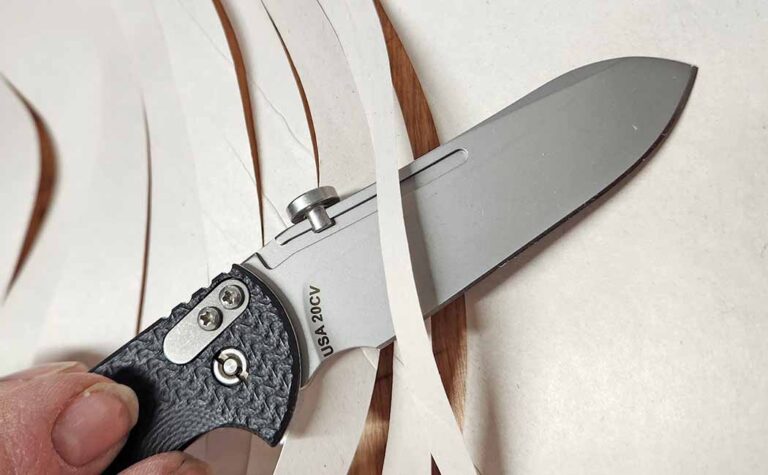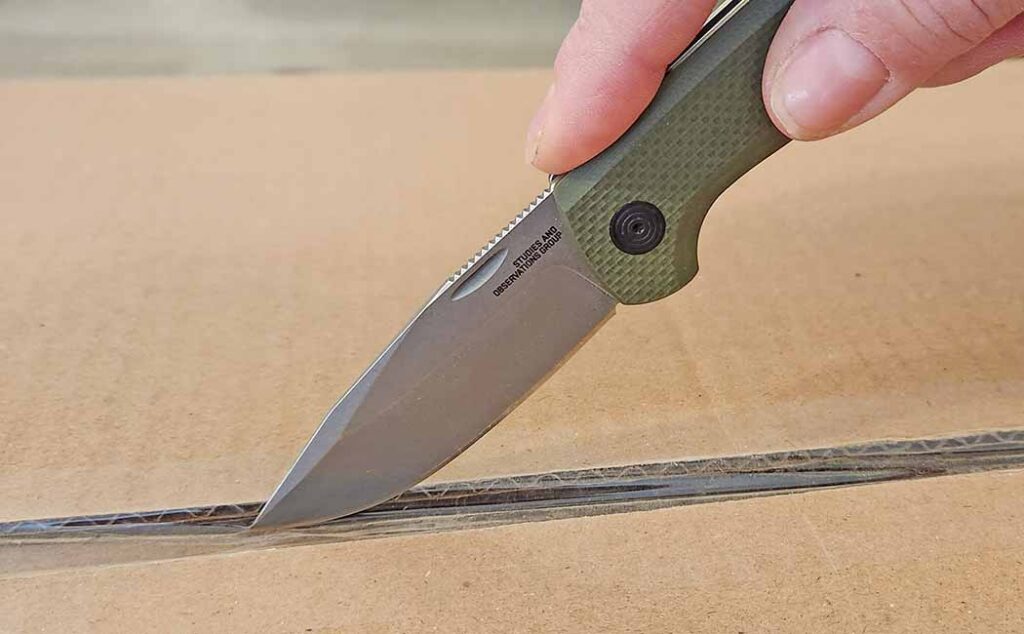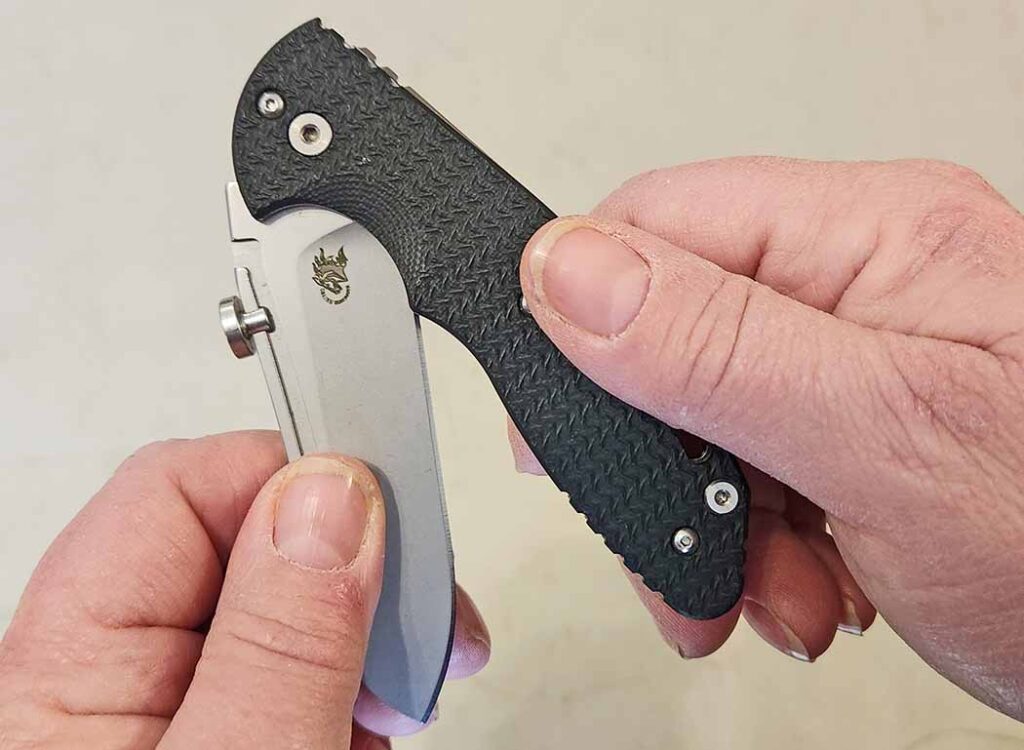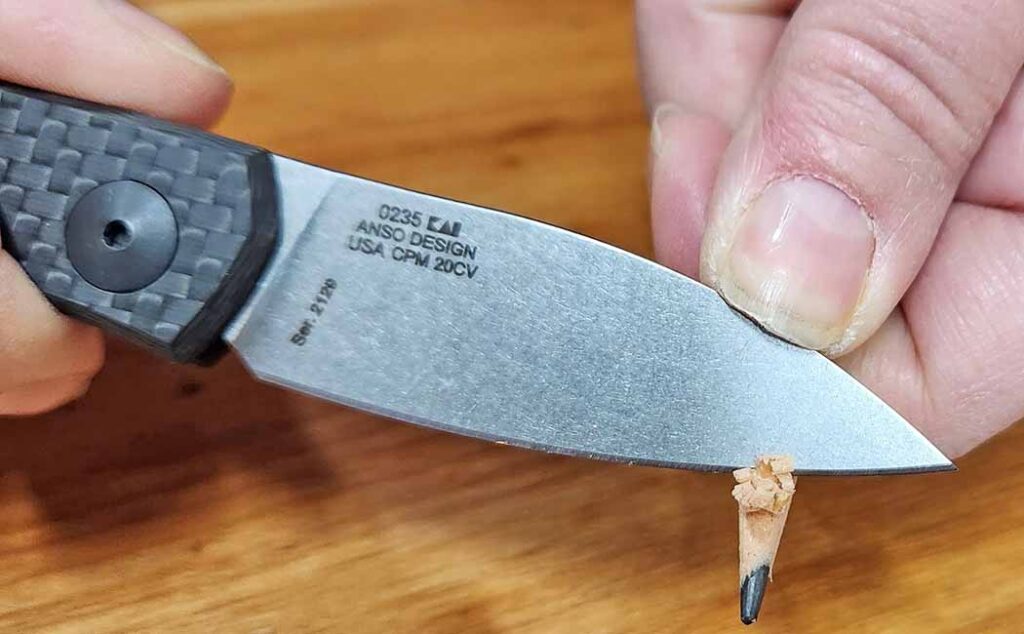
The slip joint knife endures as a time-tested design, perfect as an everyday pocket companion. Here we look at some of the best modern takes on the classic style of knife.
The slip joint is perhaps the most recognized form of folding knife. Chances are you started your knife collecting journey by buying some sort of slip joint, such as a Swiss Army knife or other multi-blade.
Slip joints have been on the comeback trail for some time now, with an increasing number of factory knife companies offering new examples of the tried-and-true design. This is good for the entire slip-joint genre, as novice collectors discover, and veteran ones rediscover, their love for the classic traditional folders.
CRKT Venandi

CRKT and custom knifemaker Richard Rogers have a few factory collaborations under their belts. Richard’s distinct style lends to knives with both a signature-refined appearance and a high level of usability. He mainly makes higher-end custom knives, and his work is sought by discerning collectors.
CRKT’s newest Rogers collaboration is the Venandi, a single-blade trapper featuring a 3-inch
blade in a modified clip-point pattern and 8Cr13MoV stainless steel. The handle is a brown-and-black G-10, and the contour brings out the woodgrain-style layers for an exciting visual pop. The triangular-shaped bolts and pivot bolt provide a distinctive touch of class, and the bomb shield is a nice touch.
Despite being a larger slip joint, at 1.8 ounces the knife is lightweight and rides comfortably inside a pocket or next to your wallet. The blade’s pull is a bit stiff and that’s on purpose. There is a half-stop, in which the blade pauses midway through opening and closing cycles. A large nail nick assists in opening. A hollow grind and a bit of a swedge dress up the blade’s appearance.
The Venandi is stylish and functional. It’s a knife you can carry when dressed up for church or the office, tackling home improvement projects, or doing yardwork. Out of the box, the blade is centered and the action is crisp.
My only complaint is the lack of a hole to attach a lanyard for grabbing at the top of the pocket for easier knife access. With an MSRP of $49.99 and made in China, the Venandi is a highly functional custom-designed folder that won’t break the budget—and it’s really good looking to boot.
Spyderco Lil Native Slipit

With optimized ergonomics for enhanced cutting performance, the Spyderco Lil Native Slipit is a compact folder that feels larger in the hand than you might think. Of course, this is no surprise as Spyderco is the master of ergonomics for smaller knives, the result being an extremely comfortable user experience.
The Slipit line of slip joints offers traditional Spyderco performance for jurisdictions—most of which are overseas—that ban lockblade folders. The company’s Native locking folders have been great sellers, and it makes sense to offer the design in a Slipit version, too.
The Lil Native Slipit’s 2.4-inch blade is CPM S30V stainless steel, well known for its edge-holding power, and features Spyderco’s signature leaf shape. A full flat grind thins the cutting edge out nicely, enabling the knife to sail through a variety of materials quickly and efficiently.
The handle is peel-ply G-10 in a texture that provides enough traction without being overly aggressive. In an open length just shy of six inches, the folder is big enough to complete most daily cutting chores.
The action is extremely smooth thanks to bronze washers and a full polished tang, allowing the blade’s spring to glide effortlessly over the surface while opening and closing. Since the Lil Native isn’t a traditional slip joint, Spyderco uses a notched joint in the tang to allow the backsprings to firmly seat to hold the blade open.
To close, applying pressure to the blade spine generates enough force to overcome the notched joint and thus allows the blade to rotate closed. The action is akin to a lockback folder—firm yet smooth. The blade hole allows you to open and close the folder easily with one hand as you would with any of the company’s lockblade models—a rarity for a slip joint. A steel pocket clip mounts in one of four configurations for carrying the Lil Native Slipit most any way you desire.
Made in the USA, the MSRP is $198.
Boker Barlow Prime EDC

The barlow is a classic pocketknife pattern many workingmen know. It’s a simple design that holds up well to a variety of slicing chores. Through the years many companies have offered their own versions of the pattern, and the Boker Barlow Prime EDC is one of the latest iterations.
Featuring an old-school design executed with modern materials, the knife has a 2.4-inch spear-point blade ground from N690 stainless steel and a satin finish. Action is smooth opening and closing. There’s also a nice half-stop.
The handle is black canvas Micarta® with a smooth polished finish that is a touchy-feely delight. Even the pins are flush with the grip surface. The handle is linerless, which helps save weight and reduce thickness. The contoured handle allows the Barlow Prime EDC to both feel terrific and ride comfortably in a pocket. Speaking of which, the knife almost disappears in the bottom of one.
Weighing in at 1.23 ounces, the Boker makes a great EDC knife. It is perfect for those who do not like bulk when carrying a pocketknife. It takes on small, mundane daily cutting tasks with ease—opening mail and boxes, packs of crackers, pesky clamshell packages, etc. It’s small enough to not attract unwanted attention. For those who like single-blade slip joints for daily carry, add this one to your list.
Made in Germany, the Boker Barlow Prime EDC has an MSRP of $185.95.
LionSteel JKCF Jack

And now, for something a bit different—the LionSteel JK3CF Jack. LionSteel’s slip joints are a departure from the norm since they have nothing but high-end materials in their construction. The JK3CF is a perfect example. Taking the traditional jackknife and putting its spin on it, LionSteel offers the knife in three configurations.
The JK3CF has all the boxes checked. It has a main blade, a screwdriver/bottle opener combo tool, and a corkscrew. The handle is carbon fiber with titanium bolsters and liners. The 3-inch main blade is a traditional clip point with a swedge. Premium M390 stainless steel provides the ultimate in edge holding. Normally M390 is reserved for tactical knives, and this might be a rare occasion that it’s used on a slip joint.
The ambidextrous long blade pulls allow quick and easy deployment. The screwdriver/bottle opener also has matching long pulls. Everything fits up on the JK3CF, including excellent craftsmanship and smooth action of the blades. The spring tension is firm and does a great job holding the blades open.
A couple of things on this one I particularly like are not commonly found on slip joints. First is the use of Torx fasteners throughout. The scales are secured by the fasteners, as well as the pivot.
Second is the crowning (rounding) of the exposed edges of the liners, backsprings, and blade spines. The extra touch provides a lot of visual pop. Not every manufacturer takes the time and effort to crown the edges, so when you see a knife that has it done, it stands out even more—and I really dig it. You can tell LionSteel took extra measures for the knife’s aesthetics.
The flat grind allows the blade to sever various materials easily, and the M390 won’t give up when other steels do. It is in it for the long haul. The handle width is perfect for use as a thumb rest to apply pressure to the blade. There’s something about using a high-end production knife made with premium materials.
The JK3CF is meant to be used, so go ahead and use it with confidence. M390 is one of my favorite go-to steels when I need the ultimate in edge holding. The blade shape is conducive to work. The flat grind cuts a variety of tough materials easily and the defined tip is a good scoring tool.
Made in Italy, the JK3CF has an MSRP of $225, which arguably is fairly steep for a production slip joint. But remember, it uses titanium and a premium blade steel.
SOG Terminus SJ

I’ve had a hit-and-miss relationship with SOG’s folders over the years. Some I’ve liked the looks of and others not so much. Some were dead-solid users, some not so much. In the Terminus, SOG provides both a solid user and an attractive knife—you know, like that girlfriend you get along with and are OK being seen with in public.
The folder has a very modern appearance. It sports a set of textured G-10 scales in OD green. The blade is saber-ground CRYO D2 tool steel and has a false edge. For those who prefer a more contemporary look you have it in the Terminus, and you don’t sacrifice utility for aesthetics.
Right off the bat the edge cut well, but just for the heck of it I gave it a good stropping and took it up a level or two. Though not heavily contoured, the grip is comfortable and provides nimble control. SOG offers a nice, genuine user in the Terminus and at a reasonable price so you can put it to work without making it a safe queen.
Hinderer XM-18 Slippy

Nothing quite says modern like a knife name that sounds like a football play. With the XM-18 Slippy slip joint, Rick Hinderer Knives executes a pocketknife design but adds Rick’s own special spin to it. At first glance you would think it is a contemporary linerlock folder. The spring system is tight to help prevent accidental blade closure. A heavy spring also makes it a bit challenging to open for me—so much so I prefer opening it with two hands rather than using the innovative thumb disc design. I just can’t seem to get an angle to easily allow me to overcome the spring tension. Hinderer has devised a design that allows you to move the thumb disc along the groove so you can find the best leverage point for your needs. My thumb is so large I can’t quite get it between the knife body and the disc.
The blade is a saber-ground sheepsfoot pattern of CPM 20V stainless steel. With a tip below center, it makes utility-style cuts simple. A pocket clip with a raised tip has no difficulty locking on a pocket rim. I had no issues while testing the XM-18 Slippy. It did everything you might ask it to do in daily life. It’s also a sturdy enough build that you can lean on it for tougher jobs.
Kershaw Zero Tolerance 0235

Carbon-fiber scales give the 0235 by Zero Tolerance (ZT) an up-to-date look as well as the appearance of a trim, lightweight package. An open-frame body structure eases the job of keeping the Jens Anso design free of pocket lint. The spear-point blade of CPM 20CV boasts a full flat grind. A reversible saber-style pocket clip provides deep pocket carry. The clip is one of my disappointments as it’s rather small and doesn’t trap most pant pocket rims well. It’s a tight fit once on a pocket, which tends to make a smooth withdrawal with my bear-paw hands difficult.
The lanyard loop on the back of the handle tends to be a European thing in my eyes, and I wouldn’t necessarily use it given its location on the knife. You can’t put it at the back because of the clip position, but nothing is stopping you from running a cord or a chain through the clip.
Thanks to a detent ball system, the blade holds open both fully and also in the half-stop position. Once the detents disengage, the blade is freewheeling. On a backspring system the tension on the blade is constant and restricts the blade from moving freely. If enough pressure is applied to break the detents free, you’ll have a blade with no resistance to it, which worries me a bit.
The knife is on the small side and works well but the lightweight feel can be a bit deceiving—especially if you equate heft with durability. Handling is no problem but, due to the lack of mass, you can feel the strain of heavier cuts through the handle. I would classify the 0235 as a gentleman’s knife given the crisp presentation with the carbon fiber—well suited for small everyday chores while acting as a showpiece.
Editor’s Note: Abe Elias and Dexter Ewing contributed to this post.
Check Out More Buyer’s Guides:
- Best EDC Fixed Blade Knife Options
- Best Bushcraft Knife: When Steel Meets The Woods
- Best Neck Knife: Options To Yoke Up With
- Best Tomahawks: Our Top Hawks For Backwoods To Battlefields
 NEXT STEP: Download Your Free KNIFE GUIDE Issue of BLADE Magazine
NEXT STEP: Download Your Free KNIFE GUIDE Issue of BLADE Magazine
BLADE’s annual Knife Guide Issue features the newest knives and sharpeners, plus knife and axe reviews, knife sheaths, kit knives and a Knife Industry Directory.Get your FREE digital PDF instant download of the annual Knife Guide. No, really! We will email it to you right now when you subscribe to the BLADE email newsletter.







Hinderer XM-18 Slippy: Oh good, you highlighted a knife that seemingly is out of stock, everywhere.
Follow-up: Recycling past articles are we?
I recently asked one of your contributors “what percent of factory slip joint knives feature a 1/2 stop?” the reply was a very small percentage. My guess is the additional production cost is the answer to the above listed interest/ inquiry. IF production cost isn’t a significant factor in the low inclusion of the half stop feature why or what is the reason for the absence of the presence of the feature?